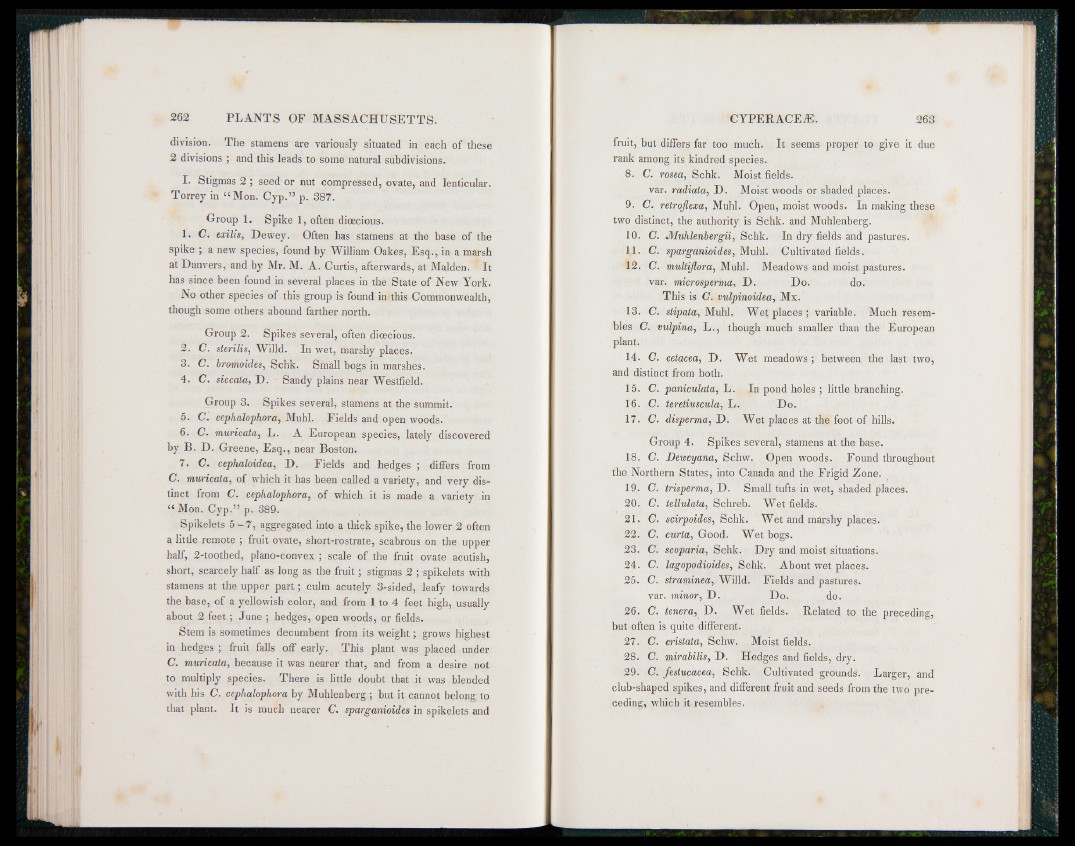
division. The stamens are variously situated in each of these
2 divisions ; and this leads to some natural subdivisions.
I. Stigmas 2 ; seed or nut compressed, ovate, and lenticular.
Torrey in “ Mon. Cyp.” p. 387.
Group 1. Spike 1, often dioecious.
1. C. exilis, Dewey. Often has stamens at the base of the
spike ; a new species, found by William Oakes, Esq., in a marsh
at Danvers, and by Mr. M. A. Curtis, afterwards, at Malden. It
has since been found in several places in the State of New York.
No other species of this group is found in this Commonwealth,
though some others abound farther north.
Group 2. Spikes several, often dioecious.
2. C. sterilis, Willd. In wet, marshy places.
3. C. bromoides, Schk. Small bogs in marshes.
4. C. siccata, D. Sandy plains near Westfield.
Group 3. Spikes several, stamens at the summit.
5. C. cephalophora, Muhl. Fields and open woods.
6. C. muricata, L. A European species, lately discovered
by B. D. Greene, Esq., near Boston.
7. C. cephaloidea, D. Fields and hedges ; differs from
C. muricata, of which it has been called a variety, and very distinct
from C. cephalophora, of which it is made a variety in
“ Mon. Cyp.” p. 389.
Spikelets 5 - 7 , aggregated into a thick spike, the lower 2 often
a little remote ; fruit ovate, short-rostrate, scabrous on the upper
half, 2-toothed, plano-convex ; scale of the fruit ovate acutish,
short, scarcely half as long as the fruit; stigmas 2 ; spikelets with
stamens at the upper p a rt; culm acutely 3-sided, leafy towards
the base, of a yellowish color, and from 1 to 4 feet high, usually
about 2 fe e t; June ; hedges, open woods, or fields.
Stem is sometimes decumbent from its weight; grows highest
in hedges ; fruit falls off early. This plant was placed under
C. muricata, because it was nearer that, and from a desire not
to multiply species. There is little doubt that it was blended
with his C. cephalophora by Muhlenberg ; but it cannot belong to
that plant. It is much nearer C. sparganioides in spikelets and
fruit, but differs far too much. It seems proper to give it due
rank among its kindred species.
8. C. rosea, Schk. Moist fields.
var. radiata, D. Moist woods or shaded places.
9. C. retrojlexa, Muhl. Open, moist woods. In making these
two distinct, the authority is Schk. and Muhlenberg.
10. C. Muhlenbergii, Schk. In dry fields and pastures.
11. C. sparganioides, Muhl. Cultivated fields.
12. C. multiflora, Muhl. Meadows and moist pastures,
var. microsperma, D. Do. do.
This is C. vulpinoidea, Mx.
13. C. stipata, Muhl. Wet places ; variable. Much resembles
C. vulpina, L ., though much smaller than the European
plant.
14- C. cetacea, D. Wet meadows ; between the last two,
and distinct from both.
15. C. paniculata, L. In pond holes ; little branching.
16. C. teretiuscula, L. Do.
17. C. disperma, D. Wet places at the foot of hills.
Group 4. Spikes several, stamens at the base.
18. C. Deioeyana, Schw. Open woods. Found throughout
the Northern States, into Canada and the Frigid Zone.
19. C. trisperma, D. Small tufts in wet, shaded places.
20. C. tellulata, Schreb. Wet fields.
21. C. scirpoides, Schk. Wet and marshy places.
22. C. curta, Good. Wet bogs.
23. C. scoparia, Schk. Dry and moist situations.
24. C. lagopodioides, Schk. About wet places.
25. C. straminea,Willd. Fields and pastures,
var. minor, D. Do. do.
26. C. tenera, D. Wet fields. Related to the preceding,
but often is quite different.
27. C. cristata, Schw. Moist fields.
28. C. mirabilis, D. Hedges and fields, dry.
29. C. festucacea, Schk. Cultivated grounds. Larger, and
club-shaped spikes, and different fruit and seeds from the two preceding,
which it resembles.